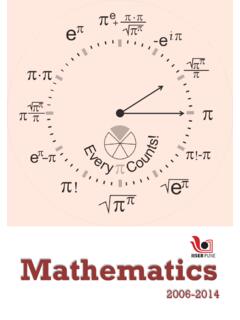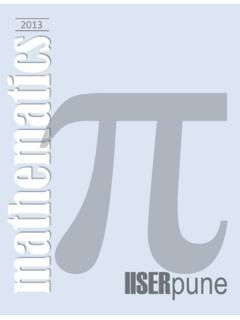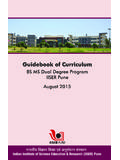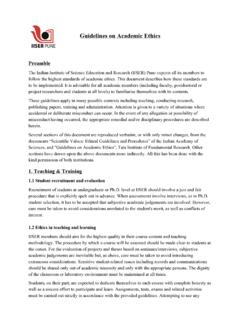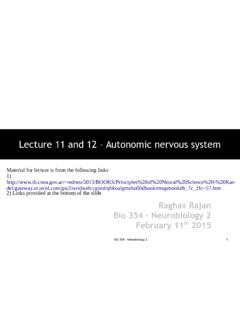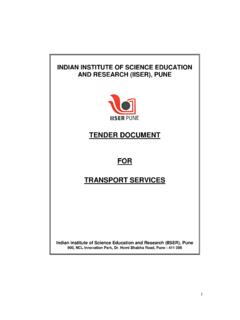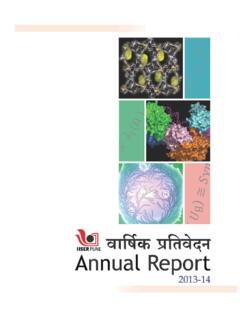Transcription of PR OBABILITY AND MA THEMA TICAL ST A TISTICS
1 PROBABILITYANDMATHEMATICALSTATISTICSP rasannaSahooDepartmentofMathematicsUnive rsityofLouisvilleLouisville,KY40292 USAvTHISBOOKISDEDICATEDTOAMITSADHNAMYPAR ENTS,TEACHERSANDSTUDENTS viviiCopyrightc ,orpartsthereof,maynotbereproducedinanyf ormorbyanymeans,electronicormechanical,i ncludingphotocopying,recordingoranyinfor mationstorageandretrievalsystemnowknowno rtobeinvented, ,eachoneintendedtoprovideanim-provemento vertheprevioustextbooks, ,theoreticalresultsarepresentedastheorem s,propositionsorlemmas, , ,inmanybooks,examplesarepresentedinabbre viatedformthatleavesoutmuchmaterialbetwe ensteps, , ,insometextbooks, ,theypassthroughageneraldiscussion, , , ; ,suchasIntroductiontoMathematicalStatist icsbyHoggandCraig, ,thesebookshavehadaprofoundimpactonme, , ,ifitweren tfortheinfinitepatienceofmywife,Sadhna, ,thetypesettingsystemdesignedbyDonaldKnu th, ,asystemfordoingmathematicsdesignedbyWol framResearch,andMAPLE.
2 Theorem..663 AnswerstoSelectedReviewExercises.. ,BertrandRusselsaid, Probabilityisthemostimportantconceptinmo dernscience,especiallyasnobodyhastheslig htestnotionwhatitmeans. ,odds,uncertainty,prevalence,risk,expect ancyetc. Weuseprobabilitywhenwewanttomakeanaffirm ation,butarenotquitesure, ,theoryofalgorithmandrandomness,religion , , , longrun , longrun .ThephilosopherandstatisticianJohnKeynes said inthelongrunwearealldead .Theobjectiveschoolusesthetheorydevelope dbyProbabilityofEvents2 VonMises(1928)andKolmogorov(1965). stheoryisthatonecanconstructprobabilitie saccordingtotherules,computeotherprobabi litiesusingaxioms, , , , , an eventAofadiscretesamplespaceS,theprobabi lityofAcanbecomputedbyusingtheformulaP(A ) =N(A)N(S)whereN(A)denotesthenumberofelem entsofAandN(S) , , , , diagram Tree diagram 1234561H1 T2H2 T3H3 T4H4 T5H5 T6H6 :Thenumberofpossibleoutcomesis2 2= :Heren1=6andn2= , :(26)3(10)3=(17576)(1000)= 17,576, b cb a cc a bd a ba b db a dc a dd a ca c bb c ac b ad b ca c db c dc b dd b aa d cb d ac d bd c aa d bb d cc d ad c bThenumberofpossibleorderedarrangementsc anbecomputedasfollows.
3 Sincethereare3positionsand4objects, , (4)(3)(2)= ,ifrpositionsaretobefilledfromnobjects,t henthetotalnumberofpossiblewaystheycanbe filledaregivenbyn(n 1)(n 2) (n r+ 1)=n!(n r)!= , ,b,andc?Answer:3P3=n!(n r)!=3!0!= :nPn=n!(n n)!=n!0!=n!. ,Vice-President,Treasurer, :24P4=(24)!(20)!=(24)(23)(22)(21)=255, , (rPr).Fromthis,wegetc=nPrrPr=n!(n r)!r!Thenumbercisdenotedby(nr).Thus,thea bovecanbewrittenas(nr)=n!(n r)!r!. (nr) :(42)(31)=(6)(3)= (x+y)2=x2+ 2xy+y2=(20)x2+(21)xy+(22)y2=2 k=0(2k)x2 (x+y)3=x3+ 3x2y+ 3xy2+y3=(30)x3+(31)x2y+(32)xy2+(33)y3=3 k=0(3k)x3 ,usinginductionarguments,wecanshowthat(x +y)n=n k=0(nk)xn (nk) (x+y)nasthentimestheproductofthefactor(x +y),thatis(x+y)n= (x+y) (x+y) (x+y) (x+y),thenthecoefficientofxn kykis(nk),thatisthenumberofwaysinwhichwe canchoosethekfactorsprovidingthey , (1+y) = 1+( 1)y+( 2)y2+ +( n)yn+ = 1+ k=1( k)yk,where isarealnumberand( k)= ( 1)( 2) ( k+ 1)k!
4 This( k) , N(thesetofnaturalnumbers)andr= 0,1,2,.., (nr)=(nn r).Proof:Bydirectverification,weget(nn r)=n!(n n+r)!(n r)!=n!r! (n r)!=(nr). (31)+(32)+(30).Answer:Sincethecombinatio nsof3thingstaken1atatimeare3,weget(31)= ,(30) ,(31)=(32)= (31)+(32)+(30)=3 + 3 + 1= 1,2,3,..,n,wehave(nr)=(n 1r)+(n 1r 1).Proof:(1+y)n= (1+y) (1+y)n 1= (1+y)n 1+y(1+y)n 1n r=0(nr)yr=n 1 r=0(n 1r)yr+yn 1 r=0(n 1r)yr=n 1 r=0(n 1r)yr+n 1 r=0(n 1r)yr+ ,weobtain(nr)=(n 1r)+(n 1r 1) (2310)+(239)+(2411).Answer:(2310)+(239)+ (2411)=(2410)+(2411)=(2511)=25!(14)!(11) != 4,457, r=0( 1)r(nr)= :UsingtheBinomialTheorem,weget(1+x)n=n r=0(nr) 1intheabove,weget0 =n r=0(nr)( 1) r=0(mr)(nk r)=(m+nk).Proof:(1+y)m+n= (1+y)m(1+y)nm+n r=0(m+nr)yr={m r=0(mr)yr}{n r=0(nr)yr}.
5 Equatingthecoefficientsofykfromthebothsi desoftheaboveexpression,weobtain(m+nk)=( m0)(nk)+(m1)(nk 1)+ +(mk)(nk k) r=0(nr)2=(2nn).Answer:Letk=nandm= ,wegetk r=0(mr)(nk r)=(m+nk)n r=0(nr)(nn r)=(2nn)n r=0(nr)(nr)=(2nn)n r=0(nr)2=(2nn). 1,2,3,.., (nk)=n 1 m=k 1(mk 1).Proof:Inordertoestablishtheaboveident ity,weusetheBinomialTheoremtogetherwitht hefollowingresultoftheelementaryalgebrax n yn= (x y)n 1 k=0xkyn 1 k=1(nk)xk=n k=0(nk)xk 1= (x+ 1)n 1nbyBinomialTheorem= (x+ 1 1)n 1 m=0(x+ 1)mbyaboveidentity=xn 1 m=0m j=0(mj)xj=n 1 m=0m j=0(mj)xj+1=n k=1n 1 m=k 1(mk 1) ,weobtain(nk)=n 1 m=k 1(mk 1). (x1+x2+ +xm)n= n1+n2+ +nm=n(nn1, n2,..,nm)xn11xn22 , n2,..,nmsuchthatn1+n2+ +nm=n,and(nn1, n2,..,nm)=n!n1!n2!.
6 ,nm!. , :ThesamplespaceofthisexperimentisS={M,F} :ThesamplespaceofthisexperimentisS={000, 001,002, ,998,999}. ,oneredandonegreen?Answer:Thesamplespace SforthisexperimentisgivenbyS={(1,1)(1,2) (1,3)(1,4)(1,5)(1,6)(2,1)(2,2)(2,3)(2,4) (2,5)(2,6)(3,1)(3,2)(3,3)(3,4)(3,5)(3,6) (4,1)(4,2)(4,3)(4,4)(4,5)(4,6)(5,1)(5,2) (5,3)(5,4)(5,5)(5,6)(6,1)(6,2)(6,3)(6,4) (6,5)(6,6)}ThissetScanbewrittenasS={(x,y )|1 x 6,1 y 6} , , ,thenA B,Ac,A :(a)S F;(b)ifA FthenAc F;and(c)ifAj Fforj 1,then j=1 , {1,2}.Answer:Thesamplespaceofthisexperim entisS={1,2,3,4,5,6}.Theevent{1,2} , :ThesamplespaceofthisexperimentisS={(x,y )|x,y= 1,2,3,4,5,6}andA={(1,6),(6,1),(2,5),(5,2 ),(4,3),(3,4)}. :F [0,1]isasetfunctionwhichassignsrealnumbe rstothevariouseventsofSsatisfying(P1)P(A ) 0foralleventA F,(P2)P(S) = 1,ProbabilityandMathematicalStatistics13 (P3)P( k=1Ak)= k=1P(Ak)ifA1, A2, A3.
7 ,Ak,.. , ,thatisP rob(A) =P(A). isaemptyset(thatisanimpossibleevent),the nP( ) = :LetA1=SandAi= fori= 2,3,.., .ThenS= i=1 AiwhereAi Aj= fori+= ,weget1 =P(S)(byaxiom2)=P( i=1Ai)= i=1P(Ai)(byaxiom3)=P(A1) + i=2P(Ai)=P(S) + i=2P( )= 1+ i=2P( ).Therefore i=2P( ) = ( ) 0byaxiom1,wehaveP( ) = ,thatdoesnotmeantheeventisempty(orimposs ible). ,ifAisaneventwithprobability1, {A1, A2,..,An}beafinitecollectionofneventssuc hthatAi Ej= fori+= (n i=1Ai)=n i=1P(Ai).Proof:Considerthecollection{A i} i=1ofthesubsetsofthesamplespaceSsuchthat A 1=A1, A 2=A2,..,A n=AnandA n+1=A n+2=A n+3= = .HenceP(n i=1Ai)=P( i=1A i)= i=1P(A i)=n i=1P(A i) + i=n+1P(A i)=n i=1P(Ai) + i=n+1P( )=n i=1P(Ai) + 0=n i=1P(Ai) ,theabovetheoremyieldsP(A1 A2) =P(A1) +P(A2)whereA1andA2aredisjoint(ormutually exclusive) , , {Oi} i=1bethecollectionofallthesingletonsets( ortheelementaryevents) i= (P3),wegetP(A) =P( i=1Oi)= i=1P(Oi).
8 ,whatistheprobabilityofgettingatleastone head?Answer:Thesamplespaceofthisexperime ntisS={HH, HT,TH, TT}.TheeventAisgivenbyA={atleastonehead} ={HH,HT,TH}. , ,wegetP(A) =P(HH) +P(HT) +P(T H)=14+14+14= , ,thentheprobabilityofAisgivenbyP(A) = :Bytheprevioustheorem,wegetP(A) =P(m i=1Oi)=m i=1P(Oi)=m i=11n= 1,2,.., ,inonerollofthedie,thatanoddnumberofdots willturnup?Answer:P({j}) j=k ,wedeterminethisconstantkbyusingtheaxiom (P2). ,wegetP(S) =P({1}) +P({2}) +P({3}) +P({4}) +P({5}) +P({6})=k+ 2k+ 3k+ 4k+ 5k+ 6k=(1 + 2 + 3 + 4 + 5 + 6)k=(6)(6+1)2k= (P2),weget21k= ,wehaveP({j}) = , (oddnumbereddotwillturnup)=P({1}) +P({3}) +P({5})=121+321+521= (n+1).Thatis,1 + 2 + 3 + + (n 2) + (n 1)+n=n(n+ 1) (1777-1855) (n+1) ,thefatherofmodernprobabilitytheory,prov edthatthesumofthefirstnoddpositiveintege rsisn2, , ,thenP(Ac) = 1 P(A) ,using(P3),weget1 =P(S) =P(A Ac)=P(A) +P(Ac).
9 AA cASBP robabilityofEvents18 Hence,weseethatP(Ac) = 1 P(A). B S,thenP(A) P(B).Proof:NotethatB=A (B\A)whereB\ ,A (B\A) = .Henceby(P3),wegetP(B) =P(A (B\A))=P(A) +P(B\A).Byaxiom(P1),weknowthatP(B\A) ,fromtheabove,wegetP(B) P(A) ,then0 P(A) :Followsfromaxioms(P1)and(P2) ,thenP(A B) =P(A) +P(B) P(A B).Proof:ItiseasytoseethatA B=A (Ac B)andA (Ac B) = .Henceby(P3),wegetP(A B) =P(A) +P(Ac B)( )ButthesetBcanalsobewrittenasB= (A B) (Ac B)ProbabilityofEvents20 Therefore,by(P3),wegetP(B) =P(A B) +P(Ac B).( )EliminatingP(Ac B)from( )and( ),wegetP(A B) =P(A) +P(B) P(A B) (A) = (B) = , P(A B) :SinceA B AandA B B, ,wegetP(A B) P(A)andalsoP(A B) P(B).HenceP(A B) min{P(A), P(B)}.ThisshowsthatP(A B) ( )SinceA B S, ,wegetP(A B) P(S)Thatis, (A) +P(B) P(A B) P(S).
10 Hence, + P(A B) + 1 P(A B).Fromthis, P(A B).( )ProbabilityandMathematicalStatistics21 From( )and( ), P(A B) (A) =12=P(B)andP(Ac Bc) = (A Bc).Answer:NoticethatA Bc=A (Ac Bc).Hence,P(A Bc) =P(A) +P(Ac Bc)=12+13= A2,thenP(A2\A1) =P(A2) P(A1).Proof:TheeventA2canbewrittenasA2=A 1 (A2\A1)wherethesetsA1andA2\ (A2) =P(A1) +P(A2\A1)whichisP(A2\A1) =P(A2) P(A1) : IR IR(thesetofrealnumbers)iscontinuousonIRi fandonlyif,foreveryconvergentsequence{xn } n=1inIR,limn f(xn) =f(limn xn). , A2,..,An,..isasequenceofeventsinsamplesp aceSsuchthatA1 A2 An ,thenP( n=1An)=limn P(An).Similarly,ifB1, B2,..,Bn,..isasequenceofeventsinsamplesp aceSsuchthatB1 B2 Bn ,thenP( n=1Bn)=limn P(Bn).Proof:Givenanincreasingsequenceofe ventsA1 A2 An wedefineadisjointcollectionofeventsasfol lows:E1=A1En=An\An 1 n {En} n=1isadisjointcollectionofeventssuchthat n=1An= n= ( n=1An)=P( n=1En)= n=1P(En)=limm m n=1P(En)=limm [P(A1) +m n=2[P(An) P(An 1)]]=limm P(Am)=limn P(An).
